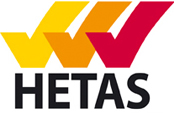- Before you open up your hearth, consider whether you want to burn coal, logs or both. Do you live in a smokeless zone? If you do, you can only burn smokeless fuels such as Home Fire, Phurnacite, Ancite, Taybrite, Supertherm, Multiheat, Briteheat Ecoal unless you buy a ‘compliant’ stove. Phone Stovefitter.com on 07932 632169 to find out more.
- Multi fuel stoves and wood burning stoves should be installed by a HETAS qualified engineer.
- Stoves become extremely hot and are designed for installation into masonry fireplaces, at least 250mm from combustible materials and fully sealed to a class 1 chimney at least 5m high.
- When you begin to use your solid fuel stove, it is vital to undergo a period of ‘burning in’. Initially build small fires and gradually increasing the size with each firing. This is to ensure that your cast iron stove anneals and does not crack with the thermal shock of first usage. This process should reward you with years of trouble free, enjoyable use.
- Remove all cooled ash from your stove and don’t allow a build up beneath the grate as it will reduce the life of the burning chamber.
- All chimneys must be swept on an annual basis as a minimum; failure to perform this vital maintenance can result in chimney fires or at worst, carbon monoxide poisoning. It may also invalidate your home insurance, please check your policy.
- Flue ways through the stove should be kept clear at all times and by removing the baffle plates in the stove we can gain access to the chimney to sweep it.
- If you are burning wood ensure its moisture content is less than 20%. Stovefitter.com can supply you with a moisture meter. If you burn wet wood the heat you create is wasted turning the moisture into steam instead of heating your room.
- If you have storage space for a log pile, buy or collect wood this year to use next year so it is dry and well seasoned.
- Stack logs in your log pile so they are covered at the top but exposed at the sides - this will make it easier for the air to circulate and dry them out. Don’t stack too thickly or the logs in the middle won’t season.
- Store a basket of seasoned logs in the house for a day or so – they’ll burn more efficiently.
- Solid fuel heating can reduce condensation, eliminating household mould which can build up with gas or electric fires. Medical research has also shown that solid fuel heating can reduce the risk of hay fever, asthma and eczema (solid fuel association).
- Homes with solid fuel heating are better ventilated than those with other forms of heating; using a chimney will draw in fresh air and remove 'polluted' air.
- Wood burns best on a bed of ash, whereas coal needs an air supply from underneath.
- Never burn treated woods, mdf, chipboard, painted wood as these emit chemicals.
- Efficient burning can be achieved by setting the stove air vents to open after stoking it. This will ensure all the gases are burned and will burn hotter.
- Clean the glass on your stove with a mixture of white vinegar with a splash of ammonia and paper towels or scrunched up newspaper for a sparkling finish.
- Cast iron stoves will rust if they get wet so always mop up any spills.
- If your stove has a flat top then you can
- boil a kettle or simmer soup or stew in a heavy based saucepan – lovely!
- cook rice puddings in a heavy based pan.
- warm plates and keep your teapot hot.
- To bake a large potato in your stove, wrap it in heavy duty foil, add a layer of ash over the embers that you are going to place the potato on. The ash protects the spud from the intense heat. Turn after 20-30 minutes. Within an hour you’ll have a beautifully cooked baked potato.
Feel free to email mark@stovefitter.com to have your tips included on this page. |





